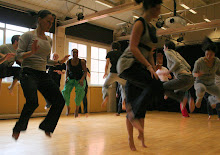1. What are the key strategies of devising that have been used through the first 5 weeks of creating Porto? Reflect briefly on how these strategies have enabled the growth and development of both individual characters and the ensemble’s idiosyncrasies. (200 words)
The main focus and strategy used in the devising process of Porto has been the element of play and disregarding the traditional text-based dominance. Through the use of improvisation and experimentation it has allowed characters to grow and progress through the liminal zone that is Porto. Even when given a stimulus or idea in the form of a task; it is the responsibility of the performer to use this stimulus and develop it, in order for them to progress and to create a piece of performance. ‘Devising a performance is a process of collective creativity that liberates the potential of individuals and groups, allowing them to create their own performance narrative.’ (Dundjerovic, 2007, p26) During the first 5 weeks, working as a ensemble and individually have proven its difficulties, but it has also allowed the emergence of relationships, and through play; it has allowed these relationships to build and develop into stronger connections. It is with these relationships that the basis of Porto is built around. In the beginning of the piece we are all individuals, not quite knowing where we are, who we are with, or where we are going. Through the evolution of these new relationships it is allowing individual characters to progress through on their journey.
2. Analyse the growth of your own character from the beginning of Porto to where you are at in the process now. State the reasons for its development/change/refinement. (200 words)
‘Every day, people around the world pick up a novel or short story, eager to be whisked away to another realm.’ (Bodden, 2008, p5) I feel like my character is trapped in a book, and trying to reach the end to find out her own outcome and fate. Over the past 5 weeks my character has developed quite significantly in the fact that in the beginning she was completely lost, with no sense of direction or security. By the end of the first 5 weeks, my character is slowly but surely starting to become comfortable with herself, and those around her; and believes that in order to interact comfortably with others she needs to have a sense of control over herself. This is an immense step in the right direction for my character, and I feel we are only just seeing the beginning of her. The character herself has many hopes and aspirations but is struggling to overcome her personal barriers in order to reach them. At the moment my character is quite disorientated and in limbo and it is surprising to see that ‘ in this state of unknowing we are able to draw on reserves from deep inside ourselves and get beyond predictable responses.’ (Free and Ramsay, 2004 p97)
3. Identify your character’s physicality through detailed analysis of its body language. (For example describe your character’s use of spine and its relationship to gravity, its shift of weight in the pelvis and even the repetition of a key gesture) (200 words)
‘We experience ourselves through our bodies. Within ourselves we make sense of the external world and at the same time use our thoughts and imaginings to propel courses of action’ (Bloom and Shreeves, 1998 p7) I am beginning to understand that my character has many attributes that are not always thought provoked. She tends to slouch her shoulders forward and not align her spine. This is a subconscious trait that my character has developed throughout the 5 weeks. This may be because she feels she is carrying unnecessary weight on her shoulders, or because she feels she is not worthy of walking straight. Pisk (1990, p13) explains that ‘the spine transmits to the spectator messages such as being tense or relaxed […] and it assists to transform the shape of the body.’ It will be interesting to see over the coming weeks if my character develops more confidence and self worth, to see if this transforms her as a person and straightens her back. ‘In performance fear and self-consciousness can undermine the breath and hence our capacity for expression. By cultivating good breathing, we can combat this danger and regain purpose and confidence.’ Free and Ramsay, 2004, p 133) I have noticed when examining my characters breathing that her breathes are short and fast. This is something I will also be interested in, in the coming weeks.
Bibliography:
BLOOM, K and SHREEVES, R. 1998. Moves- A Sourcebook of Ideas for Body Awareness and Creative Movement Hardwood Academic Publishers
BODDEN, V. 2008. Creating a Character: Dialogue and Characterization. The Creative Company
DUNDJEROVIC, A. 2007. The Theatricality of Robert Lepage. Canada: McGill-Queen’s Press
FREE, J. and RAMSAY, N. 2004. Holistic Bodywork For Performers Wiltshire: The Crowood Press
PISK, L. 1990. The Actor and His Body London: Virgin Books
NICOLE DIXON
skip to main |
skip to sidebar
Welcome to Porto2009.
This is the begining of our journey on the road of Porto2009. And the blog will give us the opportunity as a group to reflect on the work in which we have done within the sessions. We will keep you posted regarding the process we are making along the way.....
Enjoy.
Enjoy.



No comments:
Post a Comment